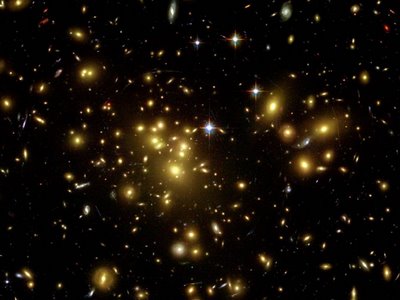 (Above: The Moon floats magically in the night sky and is our constant companion on a yearly journey around the Sun)
(Above: The Moon floats magically in the night sky and is our constant companion on a yearly journey around the Sun)Our solar system is home to a cast of captivating planets, each with its own set of unique characteristics and each providing evidence of God's masterful creativity and unimaginable scope. However, there are many objects in our midst that exist largely unknown, overshadowed by the planets they patronize or tucked away in the most remote regions of the solar system. A handful of these objects deserve special recognition for their uncommon allure, though let us begin with a very familiar and adoring face...
Moon - Also called "Luna" or even "Selene", the Moon maintains an orbit around the Earth at a distance of approximately 239,000 miles. It is one of the solar system's largest planetary satellites and is composed of a variety of primary elements. Besides the Earth it is the only celestial body upon which humans have tread and has been an object of great cultural significance (
Moonlight Sonata and "Shoot for the moon", for example).
Ganymede - The king of Jupiter's moons, Ganymede has the largest diameter of any moon in the solar system (3,270 miles) and is larger than both Pluto and Mercury. Perhaps not surprisingly, it is the only planetary satellite besides our Moon that can be seen with the naked eye (under optimal conditions).
 (Above: Jupiter's moon, Io, is the most massive moon in the solar system and resembles a block of moldy cheese more than it does a sphere of molten silicate rock)Io
(Above: Jupiter's moon, Io, is the most massive moon in the solar system and resembles a block of moldy cheese more than it does a sphere of molten silicate rock)Io - Another of Jupiter's 63 documented moons, Io is the fourth largest moon in the solar system and also the most massive
*. The wide variations in color on Io's surface are likely the result of extreme volcanic activity which is constantly reshaping the terrain. In fact, Io is the most volcanically active body in the solar system.
* The size of an object does not necessarily tell you anything about its mass (i.e. the amount of "stuff" contained within it). A beach ball can be several times larger than a bowling ball, but the latter is easily more massive. Just try dropping both of these items on your foot and you'll appreciate how the two concepts differ.Miranda - The smallest of Uranus' major moons (293-mile diameter), Miranda is a patchwork of varying terrain seemingly broken up and haphazardly reassembled by intense geological activity. While the catalyst of this activity is not entirely clear, its effects on the tiny moon's surface are quite striking. Miranda is home to one of the solar system's highest cliffs, a 12-mile-high escarpment known as Verona Rupes.

(Above: A giant space sponge or one of the solar system's most unusual objects? Say hello to Saturn's moon, Hyperion)
Hyperion - One of the largest non-spherical bodies in the solar system (200 miles in diameter at its longest dimension), Hyperion is an oddity in more ways than one. This moon has an appearance not unlike a sponge, though no one is quite sure why. As it travels around its host planet of Saturn, its highly irregular shape is at least partly to blame for a rotation best referred to as "chaotic".
90377 Sedna - The most distant natural body that has been observed in the solar system, Sedna follows a highly elliptical orbit which takes it nearly 86 billion miles away from the Sun (compared to 93 million miles for Earth). This object has no official classification, but is not unlike Pluto and other so-called "dwarf planets". Although 900 times further from the Sun than Earth, Sedna is still within the gravitational influence of our beloved daytime companion.

















